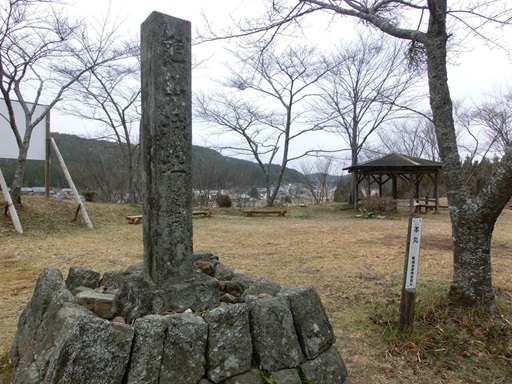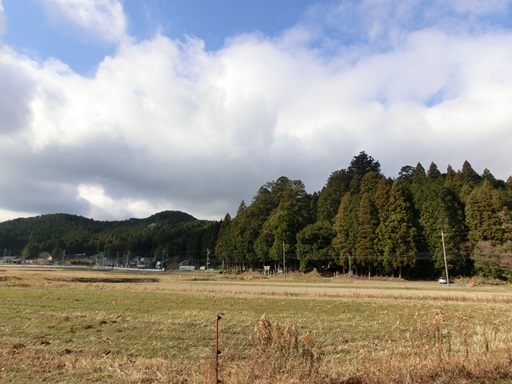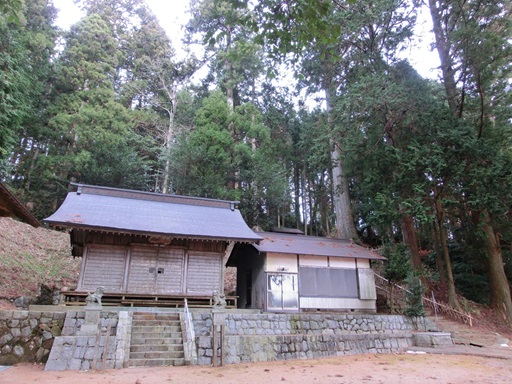
|

|
|
The view from the main bailey is very nice, as trees on the westside of the main bailey were cut. Rice fields surround around the Mikawa-Kameyama Castle and small village is located beyond the rice fields. I guess the rice fields served as moats to prevent enemies invasion. 
If you exit from the south end of the main bailey to an outer bailey and take a look back, you will see the castle gate of the main bailey. 
This view gives you good understanding how the castle gate looked like. If you go to the right in the above photo (If you go to the left after taking an exit from the main bailey), you will go to the main castle gate. The below pictures show the view of the path from the main gate to the main bailey. |

|

|
|
Earthen walls are located on the both sides of the path. The path used to be a dry moat between the earthen walls. When I visited, it was in December. The wind was blowing through the old castle, and snow was falling. I took a video as shown in below. The scenery of snow in Mikawa-Kameyama Castle was very impressive. When OKUDAIRA Sadayoshi (1537 - 1599), the fifth generation from OKUDAIRA Sadatoshi, and his son OKUDAIRA Nobumasa(1555 - 1615) were the castle lords of Mikawa-Kameyama Castle in 1571, TAKEDA Shingen(1521 - 1573) expanded his teritory to this area. TAKEDA Shingen built Furumiya Castle, just one kilometer north from Mikawa-Kameyama Castle, in order to give pressures to OKUDAIRA's father and son.OKUDAIRA Sadayoshi and Nobumasa once belonged to TAKEDA Clan due to the action of TAKEDA Shingen, but they belonged back to TOKUGAWA Ieyasu in 1573. This was the trigger of the battle of Shitaragahara. Please refer the page of "Shitaragahara Battle Field" for more detailed description of Shitaragahara Battle. http://handejapan19.html.xdomain.jp/TravelDestinations/Chubu/Shitaragahara_E.html The victory at the battle of Shitaragahara brought the great successes to OKUDAIRA Sadamada and his descendants. OKUDAIRA Sadamasa became the feudal domain lord of "Kano" in present-say Gifu and his descendants were the castle lord of Nakatsu Castle and feudal domain lord in Nakatsu, until the end of the "Edo" Age(1603 - 1868). Please refer the page of "Ruins of Nakatsu Castle" for more detailed description: http://handejapan19.html.xdomain.jp/TravelDestinations/Kyushu/NakatsuCastle_E.html MATSUDAIRA Tadaaki (1583 - 1644), the fourth son of OKUDAIRA Sadamada, became the castle lord of Mikawa-Kameyama Castle in 1602. He became the feudal lord of Ise-Kameyama domain in 1610. Then, Mikawa-Kameyama Castle became abandoned.
Furumiya Castle
Furumiya Castle was built in 1571 by TAKEDA Shingen (1521 - 1573). TAKEDA Shingen aimed to expand his territory to the west. Originally, Mikawa Province was the territory of TOKUGAWA Clan. Tsukude Area was governed by OKUDAIRA Clan, who belonged to TOKUGAWA Clan, in the fifteenth and sixteenth century.The location of Furumiya Castle was between Mikawa-Kameyama Castle, where the base of OKUDAIRA Clan in the late sixteenth century, and Kawajiri Castle, which was the first castle built by OKUDAIRA Clan when they moved to this area in the late fourteenth century or in the early fifteenth century. 
Furumiya Castle was located on a small hill. In front of Furumiya Castle, spacious rice fields stretch out. This rice field used to be a lake in the middle age. One kilometer away to this direction, the ruins of Mikawa-Kameyama Castle are located. 
On the hillside of the castle, Shiratori Shrine is located. 
If you crimb up the hill behind the shrine, you will visit the main baileys of Furumiya Castle. You will find the entrance of the main baileys. 
Furumiya Castle had two main baileys on the east and west sides. Between these two main baileys, the deep and huge dry moat is located in the middle of the castle in the north-south direction. |

|

|
|
How to get there
Other Historical Sites near by:
|
 Home Page in Japanese: "Shane's HomePage"
Home Page in Japanese: "Shane's HomePage"